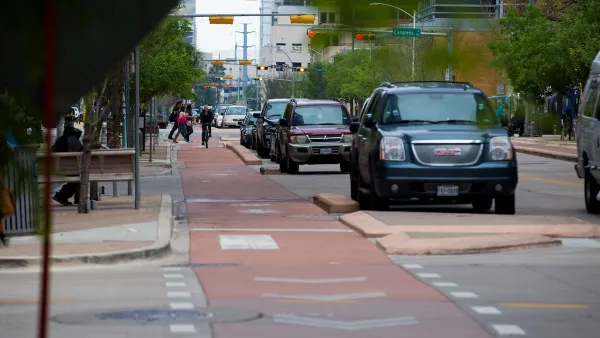As you may have heard in yesterday's Planetizen Podcast, Virginia Governor Tim Kaine doesn't like cul-de-sacs. Most news reports on the story have claimed that the state is "forbidding," "banning," or even "outlawing" the cul-de-sac. In fact, Virginia municipalities can still design, build, and approve any road patterns they wish, but the State will no longer agree to foot the bill for the ongoing maintenance of cul-de-sacs. The news item came up in a staff meeting yesterday and one colleague told us that a friend he was having dinner with declared the move "Un-American!"
As you may have heard in yesterday's Planetizen Podcast, Virginia Governor Tim Kaine doesn't like cul-de-sacs.
Most news reports on the story have claimed that the state is "forbidding," "banning," or even "outlawing" the cul-de-sac. In fact, Virginia municipalities can still design, build, and approve any road patterns they wish, but the State will no longer agree to foot the bill for the ongoing maintenance of cul-de-sacs. The news item came up in a staff meeting yesterday and one colleague told us that a friend he was having dinner with declared the move "Un-American!"
In a brilliant stroke of spin, Virginia is not posing the new legislation as a regulation that hinders individual or municipal liberties, but rather as a cost- and time-saving measure. By not having to send unwieldly maintenance and emergency vehicles up any future cul-de-sacs (or along the crowded arterials that carry every trip made from a cul-de-sac dominated subdivision), the state can respond faster to emergencies and save boku bucks on road maintenance.
My favorite news story on the subject is this one, mostly because the reporters talked to a lawyer for Biscuit Run, a hilariously named new development just outside of Charlottesville. Steven Blaine, an attorney for the Biscuit Run developer, fell into much of the same argument against cul-de-sacs that new and old urbanists alike have been using for years: "we
want to make it easy for people who live in the community to get from
one part of the community to the other." The brilliance of the Virginia arguments are that they are difficult to
oppose on a libertarian ground..."so, you want to have the liberty to
live on a cul-de-sac? Then, I assume you're also happy paying higher
taxes for the road maintenance and service, yes?" Tim Kaine makes the new urbanist arguments look somehow namby pamby, even while he accomplishes their objective.
If an editorial is more your style on this subject than a bland news article--even one about Biscuits and Running--than news, this commentary has some pretty funny hyperbole and a great accompanying photo. The author here captures my own annoyance at the opponents of this policy who claim that they prefer living on a cul-de-sac because _it's safer_. The Virginia Home Builders and others seem to believe that their children can frolick in the cul-de-sac without ever encountering danger. They forget about the social dangers of isolation and the health dangers of extraordinary commutes, but, as Tim Kaine points out, they're also forgetting about how much longer emergency rescue vehicles muct sit in traffic in a cul-de-sac-heavy road network.
Luckily for us, Roman Polanski has already made a farce of this "safety" notion with his 1966 film, Cul-de-Sac. I've never seen it, but it appears to be a pretty subversive sexual study of what happens when two criminals on the lam crash at a couple's beachfront mansion, at the end of...of course...a cul-de-sac. Nextflix queue, ho!

National Parks Layoffs Will Cause Communities to Lose Billions
Thousands of essential park workers were laid off this week, just before the busy spring break season.

Retro-silient?: America’s First “Eco-burb,” The Woodlands Turns 50
A master-planned community north of Houston offers lessons on green infrastructure and resilient design, but falls short of its founder’s lofty affordability and walkability goals.

Delivering for America Plan Will Downgrade Mail Service in at Least 49.5 Percent of Zip Codes
Republican and Democrat lawmakers criticize the plan for its disproportionate negative impact on rural communities.

Test News Post 1
This is a summary

Test News Headline 46
Test for the image on the front page.

Balancing Bombs and Butterflies: How the National Guard Protects a Rare Species
The National Guard at Fort Indiantown Gap uses GIS technology and land management strategies to balance military training with conservation efforts, ensuring the survival of the rare eastern regal fritillary butterfly.
Urban Design for Planners 1: Software Tools
This six-course series explores essential urban design concepts using open source software and equips planners with the tools they need to participate fully in the urban design process.
Planning for Universal Design
Learn the tools for implementing Universal Design in planning regulations.
EMC Planning Group, Inc.
Planetizen
Planetizen
Mpact (formerly Rail~Volution)
Great Falls Development Authority, Inc.
HUDs Office of Policy Development and Research
NYU Wagner Graduate School of Public Service






























